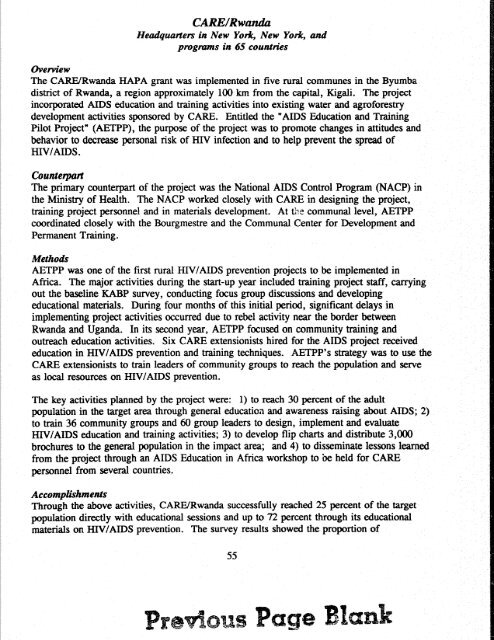The HAPA Support Program - usaid
The HAPA Support Program - usaid
The HAPA Support Program - usaid
You also want an ePaper? Increase the reach of your titles
YUMPU automatically turns print PDFs into web optimized ePapers that Google loves.
CARE/Rwanda<br />
Headquatters in New Yorlc, New York, and<br />
programs in 65 countries<br />
Overview<br />
<strong>The</strong> CARE/Rwanda <strong>HAPA</strong> grant was implemented in five rural communes in the Byumba<br />
district of Rwanda, a region approximately 100 km from the capital, Kigali. <strong>The</strong> project<br />
incorporated AIDS education and training activities into existing water and agroforestry<br />
development activities sponsored by CARE. Entitled the "AIDS Education and Training<br />
Pilot Project" (AETPP), the purpose of the project was to promote changes in attitudes and<br />
behavior to decrease personal risk of my infection and to help prevent the spread of<br />
HIV!AIDS.<br />
Counterpart<br />
<strong>The</strong> primary counterpart of the project was the National AIDS Control <strong>Program</strong> (NACP) in<br />
the Ministry of Health. <strong>The</strong> NACP worked closely with CARE in designing the project,<br />
training project personnel and in materials development. At the communal level, AETPP<br />
coordinated closely with the Bourgmestre and the Communal Center for Development and<br />
Permanent Training.<br />
Methods<br />
AETPP was one of the first rural liN!AIDS prevention projects to be implemented in<br />
Africa. <strong>The</strong> major activities during the start-up year included training project staff, carrying<br />
out the baseline KABP survey, conducting focus group discussions and developing<br />
educational materials. During four months of this initial period, significant delays in<br />
implementing project activities occurred due to rebel activity near the border between<br />
Rwanda and Uganda. In its second year, AETPP focused on community training and<br />
outreach education activities. Six CARE extensionists hired for the AIDS project received<br />
education in HIV/AIDS prevention and training techniques. AETPP's strategy was to use the<br />
CARE extensionists to train leaders of community groups to reach the population and serve<br />
as local resources on mvIAIDS prevention.<br />
<strong>The</strong> key activities planned by the project were: 1) to reach 30 percent of the adult<br />
population in the target area through general education and awareness raising about AIDS; 2)<br />
to train 36 community groups and 60 group leaders to design, implement and evaluate<br />
liN!AIDS education and training activities; 3) to develop flip charts and distribute 3,000<br />
brochures to the general population in the impact area; and 4) to disseminate lessons learned<br />
from the project through an AIDS Education in Africa workshop to be held for CARE<br />
personnel from several countries.<br />
Accomplishments<br />
Through the above activities, CARE/Rwanda successfully reached 25 percent of the target<br />
population directly with educational sessions and up to 72 percent through its educational<br />
materials on HIV/AIDS prevention. <strong>The</strong> survey results showed the proportion of<br />
55<br />
Previous Page Blank

















